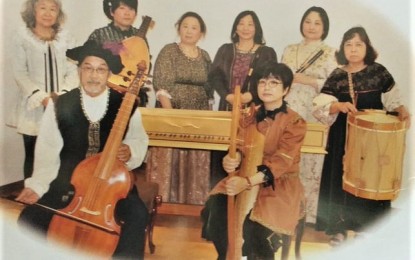
OLDIES BUT GOODIES. The Friends of Collegio, a seven-piece musical ensemble from Amakusa, Kumamoto, Japan will play at the San Agustin Church in Intramuros, Manila on July after taking the stage in Baguio as part of the Filipino-Japan friendship anniversary in Baguio. The seven (from front left) Hirayama Teruaki and Harada Aya. Back from left: Matsumura Fumiyo, Kido Hiroyoshi, Yasuo Noboku, an unidentified supporter, Yosioka Nagusa and Uwaguchi Hiroko. Hirayama crafted all the 16th century instruments they use. (File photo from Friends of Collegio)
BAGUIO CITY – A group of out of time seven musicians with ancient instruments, garbed in clothes pretty much in fashion during the time of Queen Elizabeth I are on their way to the Metro to conquer the Manilans – with their music, after Baguio.
Unlike their countrymen who wanted to take Manila some 500 years ago to expand Japanese rule in the Pacific region, the Friends of Collegio from Amakusa, Kamomoto prefecture of Japan, a seven-musician ensemble want only to share the music which the Christians of Japan have loved for more than 500 years.
Led by Hirayama Teruaki, a master craftsman specializing in 16th-century European instruments, the ensemble wants to take the San Agustin Church in Intramuros, Manila on July 23, by storm after their successful performance at the Saint Louis University Center for the Culture and Arts last July 21.
The group was in Baguio on the invitation of the Japanese association in northern Luzon as part of 10th year Filipino-Japanese friendship. Their visit and sharing of the Japanese music is also a part of the Tanabata festival, a summer festival in Japan which is celebrated in the city every July since 2010 with the help of the Japanese embassy.
The encore, a renaissance rendition of Bahay Kubo nearly brought the house down during their afternoon performance as part of the 10th year Philippine – Japanese friendship day and the “Tanabata Festival”.
Hirayama is armed with a self-made “viola de gamba”, a ribbed musical instrument popular in Europe in the 16th to 18th century played between the legs (gamba is legs in Italian). Made of wood, with no modern or plastic component, the viola has strings made from ox gut, “that is the strongest material the renaissance instrument makers could get,” said Hirayama through interpreter Julian Claresby after the performance on Sunday.
Claresby is an Englishman married to a Kamamoto lass, who served as master of ceremony during the two-hour performance on Sunday.
When the ensemble failed to bring their virginal, a 16th to 17th century harpsichord-like instrument (piano-like), Hirayama fashioned a smaller version which he did, amazingly, in just two months, Claresby said.
“The airline won’t allow us to bring it here, because it is too big,” said Claresby referring to the ensemble’s original virginal, whose insides were delicately painted with sakura, while its cover the forested coasts of Amakusa. Both were painted by the over 60 years old Hirayama, who dabbles in painting.
The other members of the ensemble are Matsumura Fumiyo, Kido Hiroyoshi, Uwaguchi Hiroko, Yasou Nobuko, Harada Aya, and Yosioko Nagisa,
Matsumura Fumiyo sits and plays for the ensemble like a typical lady in the Elizabethan court in England or the Medici’s in Florence, Italy during the time of Leonardo da Vinci.
Kido Hiroyoshi, garbed in black hose and doublet with a feathered hat, plays the lute, a mandolin-like stringed instrument that Hirayama painstakingly made for Kido.
Uwaguchi Hiroko plays the tabor, a small drum that has been in use since the Medieval (pre-16th century).
Three female musicians play the recorder. A renaissance flute: Yasou Nobuko who is also the group’s main vocalist; Harada Aya, who plays also the gothic harp, small harp used by troubadours since the middle ages, and crumhorn, a J-shaped woodwind instrument of German origin; and, Yosioko Nagisa, who also plays the crumhorn.
Harada and Yosioko are also back-up singers to Yasou.
Yasou, Harada, and Yosioko during their demonstration of the recorder played the “Voltes V” opening song with Yasou on vocals that sent the crowd, mostly young music students, into a frenzy.
Listen, Hirayama, who can barely speak English, said to fully appreciate their music, one must really listen.
“Modern (musical) instruments are loud, even those used in classical performances like an orchestra because the instruments are (partly) made of plastic,” he said through Claresby.
He said his instruments may not be as sturdy as the modern ones but they produce notes that are pure, the tonality is much better.
“Performances by a group of musicians then were not loud,” he said.
The ensemble played popular tunes in the 16th century when the Tensho embassy of Christian Japanese nobles went to Europe in the 1580s and brought back the same to Amakusa and Shimabara in Nagasaki.
Shimabara’s promotional map “Come travel through time, through Minamishimabara’s history, a past interwoven with European cultural influences.”
The SLU concert orchestra closed the show with two anime (Japanese cartoons) themes: Sakura Sakura and Voltes V, which were both received positively by a predominantly anime crazed young audience.
Minamishimabara (Shimibara of old) in Nagasaki and Amakusa in Kumamoto are the westernmost prefectures of Japan. These localities have seaports that served as an entry point of Christian missionaries led by Francis Xavier who converted the locals of Shinto-Buddhists belief in the 1540s.
When Ieyasu Tokugawa started the 260-year reign of the Tokugawa shoguns in 1600, the Christians of western Japan were persecuted that led to the Shimabara – Amakusa revolt of 1637 killing more than 27,000 locals, mostly peasants, including children.
The peasants revolted because the Shimabara rulers raised taxes to build their castle and help the Tokugawa rulers in their quest to gain Manila. As a result, the Christians either went into hiding or fled the country. Japan was closed from the rest of the world after that. (PNA)
